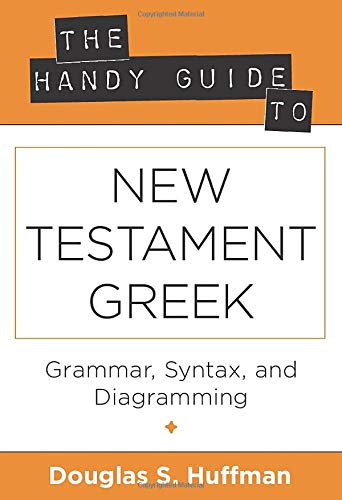The Handy Guide to New Testament Greek: Grammar, Syntax, and Diagramming
Written by Douglas S. Huffman Reviewed By Brian J. TabbProfessor Douglas Huffman of Biola University has written a compact, useful reference book intended to serve students and pastors in their ongoing study of the Greek New Testament. The Handy Guide includes many charts and summaries of basic and intermediate Greek morphology, grammar, and syntax, as well as a clear and practical introduction to “phrase diagramming” and a select bibliography for further study.
In Part 1, Huffman concisely reviews key material typically covered in first-year biblical Greek courses, including the alphabet; breathing marks and accents; basic usage and morphology for nouns, adjectives, and pronouns; and prepositions (pp. 7–23). He then summarizes basic features of Greek verbs and offers select conjugation paradigms and principle parts (pp. 23–52).
Part 2 overviews important points of Greek syntax covered in standard intermediate grammars, including Greek cases, the article, verbs, and conditional sentences. Huffman writes as a seasoned teacher, offering lucid and often memorable summaries throughout. For example, he calls the genitive “the most flexible ‘of’ case,” which “typically generates some description of the preceding (or head) noun” (p. 54). He then surveys twenty ways NT authors employ the genitive, with a clear definition and specific example of each (except for the genitive of direct object). Huffman explains that Greek verb tenses do not have a time-based orientation but indicate an author’s portrayal of an action (aspect) and spatial vantage point (proximity or remoteness). The present and imperfect tenses encode progressive aspect (imperfective), the future and aorist summary aspect (perfective), and the perfect and pluperfect stative aspect (pp. 61–62). Huffman notes that scholars debate the aspect of the perfect and future tense-forms (without engaging in the specifics of the discussion), and he follows Stanley Porter’s view of aspect and adapts Con Campbell’s treatment of spatial vantage point. Huffman’s own positions are set forth in more detail in his forthcoming monograph, Verbal Aspect Theory and the Prohibitions in the Greek New Testament (Peter Lang).
Part 3 introduces readers to phrase diagramming, a method for picturing the flow of thought in a biblical text, elsewhere called “phrasing” (Mounce, Greek for the Rest of Us) or “grammatical diagramming” (Guthrie and Duvall, Biblical Greek Exegesis). Huffman notes three other approaches (technical diagramming, semantic diagramming, and arcing) but prefers phrase diagramming as a time-efficient way to “produce an outline by which to preach/teach a particular passage of Scripture” (p. 85). Phrase diagramming includes eight steps, which Huffman illustrates on 1 Peter 1:3–9: (1) establish the limits of the paragraph; (2) divide the sentences into their natural phrases; (3) identify the main clauses of the paragraph; (4) indent the subordinate phrases and clauses; (5) draw arrows from each subordinate phrase; (6) add semantic labels; (7) mimic the Greek diagram with the English text; (8) craft a sermon/lesson outline from the diagram (pp. 87–97).
In preparation for this review, I assigned The Handy Guide as a supplemental textbook for a college-level intermediate Greek course I recently taught, with somewhat mixed results. Positively, Huffman’s introduction to “phrase diagramming” was very helpful—Part 3 alone is worth the price of the book, and it proved a steady guide for my students as they learned this useful method. Part 1 includes some useful charts and overviews of beginning Greek material, such as rules for accents and contraction (pp. 8, 13). Part 2 helpfully summarized much of the material covered at greater length by standard intermediate grammars such as Wallace, Basics of New Testament Syntax, and his succinct explanation of verbal aspect is commendable. Further, the book’s compact handbook size facilitates its use as a ready reference while reading the Greek NT.
On the other hand, I found the roughly 25% of the book devoted to various verb paradigms and select principle parts somewhat difficult for students to navigate. The summary parsing chart on p. 25 is less comprehensive than Mounce’s “master verb chart” (Basics of Biblical Greek, 340) or Porter’s “verb formulas” (Fundamentals of New Testament Greek, 385–87). Further, the book does not include an index or list each paradigm in the table of contents, making it challenging to locate quickly the needed paradigm. Additionally, Steven Runge, Discourse Grammar of the Greek New Testament (Hendrickson, 2010) and Frederick Danker, The Concise Greek-English Lexicon of the New Testament (University of Chicago Press, 2009) are notable omissions from the bibliography. These minor criticisms aside, I commend Professor Huffman’s book as a supplemental textbook for biblical Greek students and instructors and as a very helpful resource for seminary graduates, pastors, and others wanting help for reading and studying the Greek NT.
Brian J. Tabb
Brian Tabb is interim president, academic dean, and professor of biblical studies at Bethlehem College and Seminary in Minneapolis and general editor of Themelios.
Other Articles in this Issue
Too often people think of the Reformation in terms of an abstract theological debate...
Abstract: Evangelical Faith and the Challenge of Historical Criticism, edited by Christopher Hays and Christopher Ansberry, argues that evangelical scholars have failed to embrace historical criticism to the extent that they could and should...
Thomas Prince, editor of The Christian History—the first religious periodical in American history—could hardly have invented the Great Awakening, as Frank Lambert argues...
Theology is first and foremost about who God is and then about what he has done...
I would like to consider several elements in reviewing Bray’s work...







